Kneel into the story of carob pods in the Bible, a symbol of humility and survival that holds untold lessons for the modern soul.
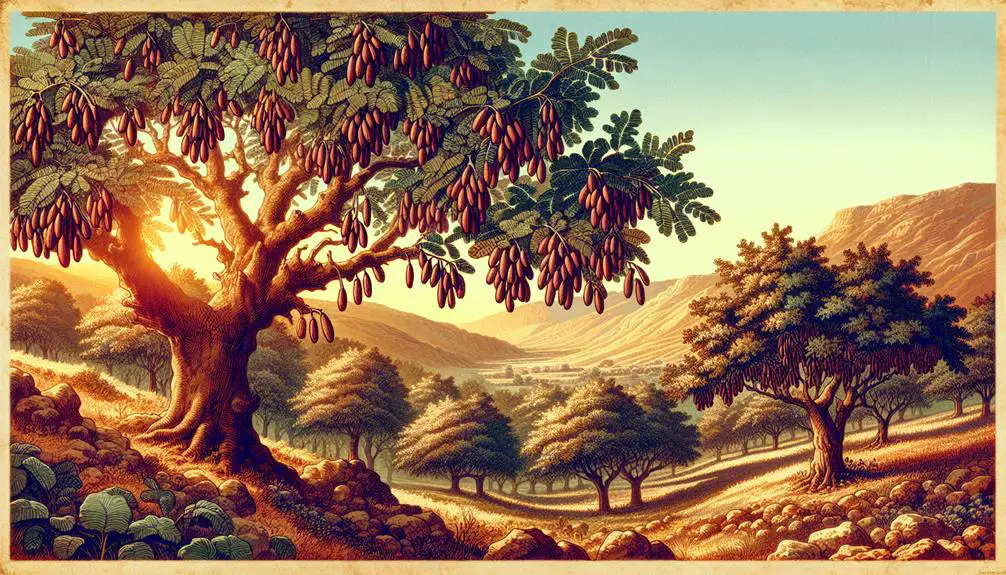
Carob Pods in the Bible
In the Parable of the Prodigal Son, you might recall the desperate point at which the son finds himself craving the carob pods he's feeding to the pigs, a poignant detail illustrating his downfall. This reference isn't just a random choice; carob pods hold significant historical and symbolic weight within the Bible, hinting at themes of humility, repentance, and survival.
As you explore the layers behind this seemingly simple food, you'll uncover insights into its nutritional value, its role in ancient diets, and even how it contrasts with manna, the divine sustenance. The journey through the biblical landscape of carob pods invites you to uncover how these stories resonate with modern spiritual lessons, offering a fresh perspective on an ancient text.
Key Takeaways
- Carob symbolizes spiritual nourishment and resilience in biblical texts.
- The Prodigal Son parable uses carob to represent humility and redemption.
- Carob's nutritional value highlights its importance in ancient diets and teachings.
- Its role in biblical stories underscores carob's spiritual and material significance throughout history.
Historical Context

Throughout history, carob pods have held significant cultural and economic roles, notably within the context of biblical narratives where they symbolize sustenance and humility. You might find it intriguing to explore how carob cultivation has evolved over the centuries, adapting to various geographical and climatic conditions, leading to a rich diversity of regional varieties. This adaptability hasn't only ensured the survival of carob but also its proliferation across different cultures and regions.
Delving deeper, you'll discover that carob cultivation techniques have been refined through generations. Initially, carob trees were valued for their hardiness and ability to thrive in arid conditions where other crops failed. This resilience made them a reliable source of sustenance for many communities. Over time, agricultural practices evolved, enhancing the yield and quality of carob pods. These practices included selective breeding, which led to the development of regional varieties with distinct characteristics, such as pod size, sweetness, and texture.
Analyzing the historical context of carob, it becomes evident that its significance extends beyond mere nutritional value. Carob cultivation has been intertwined with economic activities, serving as a staple in trade routes across the Mediterranean and Middle East. Each region boasted its unique variety of carob, which was a source of pride and economic prosperity. This diversity of regional varieties not only reflects the adaptability of carob but also the cultural nuances that shaped its cultivation and consumption.
In essence, the historical journey of carob cultivation is a testament to human ingenuity and adaptability. It showcases how a humble pod has woven itself into the fabric of various cultures, leaving a lasting legacy that transcends its biblical symbolism.
Biblical References
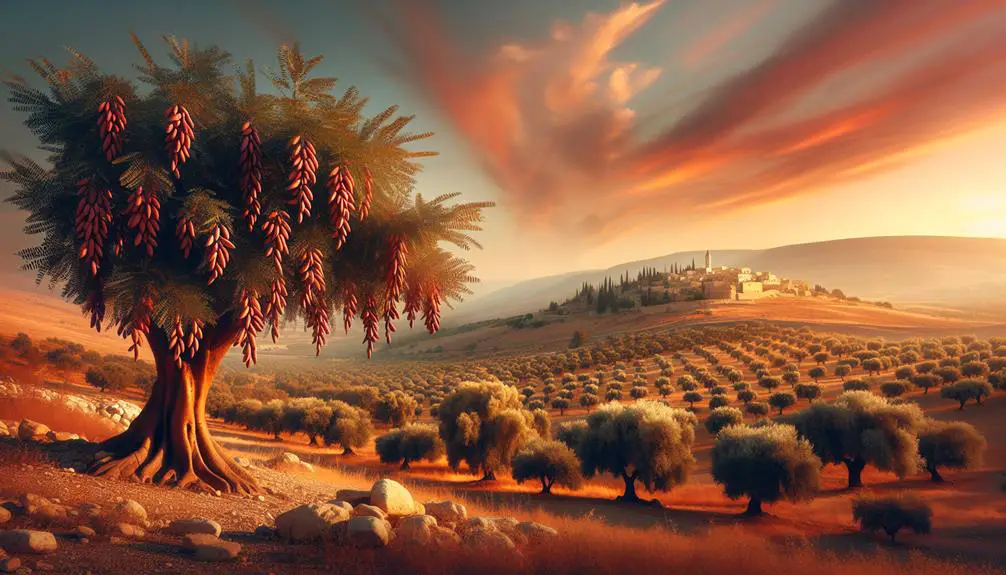
You'll find that the Bible references carob pods in contexts that are rich with symbolic meaning and cultural significance. Specifically, the Prodigal Son parable uses carob to illustrate themes of repentance and redemption, highlighting its role in ancient diets as a nutritional source.
This exploration will uncover how these references contribute to our understanding of biblical narratives and the everyday lives of historical communities.
Carob's Symbolic Meaning
In biblical texts, carob holds significant symbolic meaning, often representing sustenance and humility in times of hardship. This symbolism extends beyond mere narrative to reflect the broader cultural and agricultural practices of ancient times.
- Carob Cultivation:
It thrived in arid conditions, symbolizing resilience and providence. The meticulous care in cultivating carob mirrored the perseverance required in spiritual faith.
- Sustenance:
As a food source, carob's nutritional value underscored the idea of divine provision during lean periods, emphasizing a reliance on spiritual rather than material sustenance.
- Contemporary Recipes:
Modern utilization of carob in recipes echoes the ancient tradition of making do with available resources, underscoring humility and simplicity.
Analyzing carob's symbolism thus unravels layers of moral and spiritual teachings, pertinent across ages.
Prodigal Son Parable
One of the most illuminating references to carob in biblical literature is found within the Parable of the Prodigal Son, where it symbolizes profound spiritual hunger and humility. This parable narrates a young man's journey from reckless indulgence to utter destitution, culminating in his menial job of feeding pigs carob pods.
At this nadir, he embodies lost identity, craving the pods he feeds the swine, a poignant marker of his fall from grace. The carob's presence underscores his desperation and self-realization, prompting his return home. This return is met with his father's forgiveness, illustrating unconditional love and acceptance.
The carob pods, thus, serve not just as a dietary detail but as a narrative fulcrum pivoting the son from degradation to redemption, encapsulating the themes of lost identity and the transformative power of a father's forgiveness.
Ancient Nutritional Source
Beyond its symbolic significance, carob's mention in biblical texts reflects its role as a crucial nutritional source in ancient diets, underscoring its importance in historical and religious contexts. The emphasis on carob cultivation highlights a deep understanding of its health benefits and its vital contribution to sustenance. Analyzing this, you'll discover:
- Carob cultivation was advanced for its time, indicating a sophisticated agricultural knowledge base.
- Its health benefits are numerous, including being rich in fiber, antioxidants, and vitamins.
- Carob's mention in scripture not only provides insight into ancient diets but also signifies its value beyond mere sustenance, possibly as a metaphor for spiritual nourishment.
This multi-faceted role of carob in ancient times showcases its enduring significance across cultures and eras.
Symbolism and Meaning
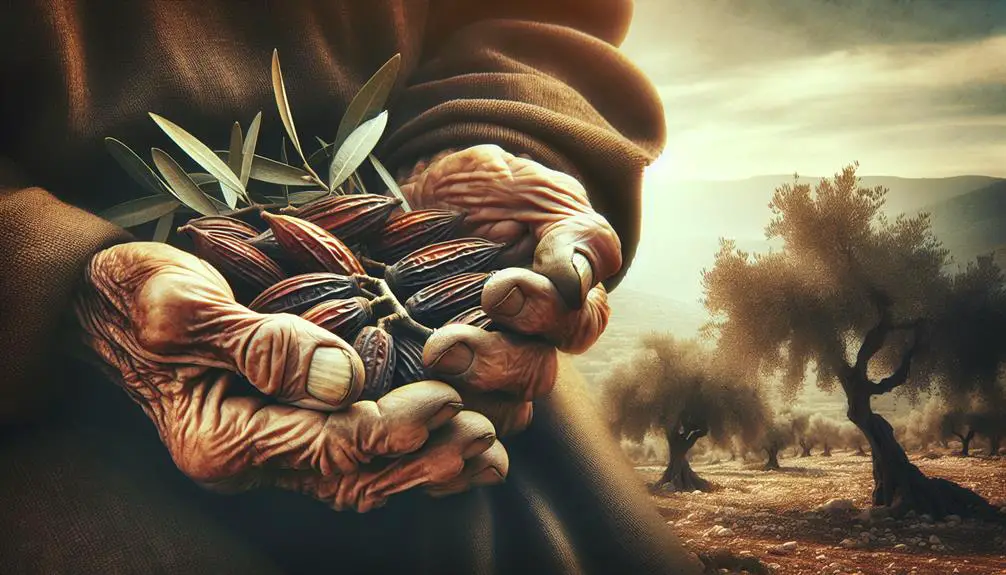
You'll find that carob pods carry profound symbolism and meaning within biblical texts, reflecting both spiritual significance and cultural interpretations. These elements not only illuminate the biblical narrative but also offer insights into the everyday lives and beliefs of ancient peoples.
Through examining their biblical importance and how cultures have understood them, you gain a deeper appreciation for their role in religious and historical contexts.
Biblical Significance
Carob pods, mentioned in the Bible, symbolize sustenance and humility, reflecting their importance in ancient diets and spiritual teachings. This significance is deeply rooted in:
- Carob cultivation: Historically, carob trees were cultivated for their hardy nature and nutritious pods. These trees thrived in the harsh climates of the Middle East, providing a reliable food source.
- Religious rituals: Carob pods were often associated with simplicity and asceticism in religious contexts. Their inclusion in rituals underscored values of modesty and self-denial.
- Spiritual symbolism: In biblical narratives, carob represents providence and resilience. Its presence in stories highlights themes of survival, redemption, and the humility of relying on nature's gifts.
Analyzing these elements reveals the carob's multifaceted role in biblical times, underscoring its cultural and spiritual significance.
Cultural Interpretations
Exploring the cultural interpretations of carob pods reveals their profound symbolism and meaning across various societies, reflecting deep-rooted spiritual and material values. These pods, often intertwined with trade routes, have transcended their initial culinary uses to embody a rich tapestry of cultural significance.
Culture |
Symbolism |
|---|---|
Ancient Near East |
Fertility and abundance |
Mediterranean |
Sustenance and health |
Biblical times |
Humility and repentance |
Modern culinary |
Sustainable alternative |
Global trade |
Connectivity and exchange |
This table underscores the versatility of carob pods, not only as a food source but as a symbol of life's interconnectedness through trade routes and culinary practices. Their journey from ancient times to modern tables exemplifies a legacy of adaptability and resilience, offering insights into how past societies valued and utilized this remarkable resource.
Nutritional Value

Rich in vitamins and minerals, carob pods offer significant nutritional benefits that merit closer examination. As you delve into the world of ancient foods, you'll find that carob recipes have stood the test of time, not just for their flavor but also for their health advantages. Despite this, there have been some health controversies surrounding carob, primarily due to misunderstandings about its sugar content and allergenic potential. However, when analyzed within a scholarly context, the evidence overwhelmingly supports carob's nutritional value.
To make this analysis more engaging, consider the following key nutritional components of carob:
- High Dietary Fiber: Carob pods are an excellent source of dietary fiber, promoting digestive health and contributing to a feeling of fullness, which can aid in weight management.
- Rich in Antioxidants: They contain polyphenols, antioxidants that help protect the body against oxidative stress and may reduce the risk of chronic diseases.
- Low in Fat and Calories: Despite their sweet flavor, carob pods are naturally low in fat and calories, making them a healthier alternative to many sweets and chocolates.
In a scholarly examination, it's essential to contextualize these benefits within a broader nutritional perspective. Carob's high calcium content, absence of caffeine, and gluten-free nature make it a versatile ingredient in diets restricted by health concerns or personal choices. Thus, despite the controversies, the nutritional profile of carob pods suggests they aren't just historically significant but remain relevant in contemporary discussions on health and diet.
Carob Vs. Manna

Having established the nutritional value of carob pods, it's crucial to examine how they compare to manna, a substance of biblical fame and historical significance. The comparison between carob and manna offers fascinating insights into ancient diets and their cultural implications. Carob cultivation has been a part of Mediterranean agriculture for millennia, known for its resilience and the nutritional value of its pods. In contrast, manna, described in the Bible as a divine sustenance provided to the Israelites, has a mysterious nature and a composition that's been the subject of much speculation.
Feature |
Carob Pods |
Manna |
|---|---|---|
Origin |
Earthly, through cultivation |
Heavenly, divine provision |
Nutritional Value |
High in fiber, vitamins, and minerals |
Described as "bread from heaven" |
Sustainability |
Renewable through carob cultivation |
Temporary, ceased with Canaan entry |
Cultural Significance |
Symbol of sustenance in hardship |
Symbol of divine care and provision |
This table highlights the stark differences in origin, nutritional content, sustainability, and cultural significance between the two. Carob's earthly cultivation contrasts with manna's divine, yet temporary provision. While both served as vital sources of sustenance, their roles and implications within their respective narratives diverge significantly. Carob's association with survival and resilience, particularly in the context of carob cultivation, stands in contrast to manna's representation of transient divine intervention. This manna comparison not only elucidates the physical differences but also invites reflection on the broader themes of providence, reliance, and survival strategies in ancient times.
The Parable of the Prodigal Son
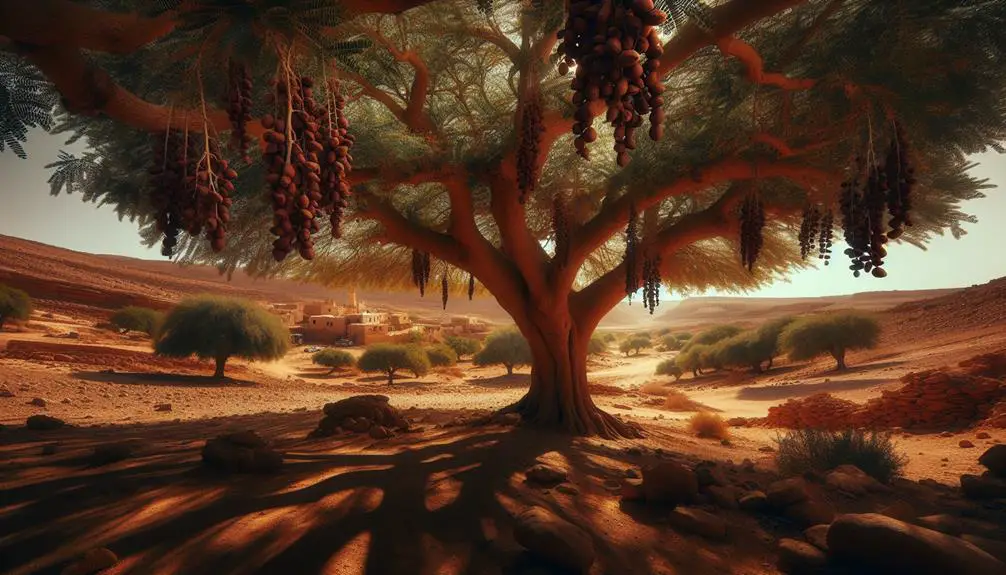
In the Parable of the Prodigal Son, carob pods serve as a poignant symbol of destitution and repentance, marking a pivotal moment in the younger son's journey towards self-realization and reconciliation.
This narrative, rich with themes of family dynamics and financial recklessness, offers a profound insight into the consequences of one's actions and the power of forgiveness.
You can understand the significance of carob pods in this context through several key points:
- Symbol of Poverty: The moment the younger son finds himself enviously eyeing the carob pods he's feeding to pigs signifies his utter desperation. It's a stark indicator of how far he's fallen from the luxury he once knew, highlighting the severity of his financial recklessness.
- Catalyst for Repentance: This humbling experience with the carob pods propels the son to reflect on his actions and decide to return to his father. It's not just physical hunger that drives him; it's a profound spiritual hunger for reconciliation and redemption. This reflects the depth of his transformation, from arrogance to humility.
- Representation of Hope: Interestingly, the carob pods also symbolize the possibility of renewal. Despite the son's grave mistakes, his return signifies that restoration within family dynamics is possible, emphasizing the forgiving nature of the father figure.
Analyzing the Parable of the Prodigal Son, you gain insights into the complexities of human behavior, especially regarding family dynamics and the consequences of financial recklessness.
The carob pods, in their humble nature, encapsulate the essence of repentance and the hopeful journey back to familial unity and personal integrity.
Carob in Ancient Diets
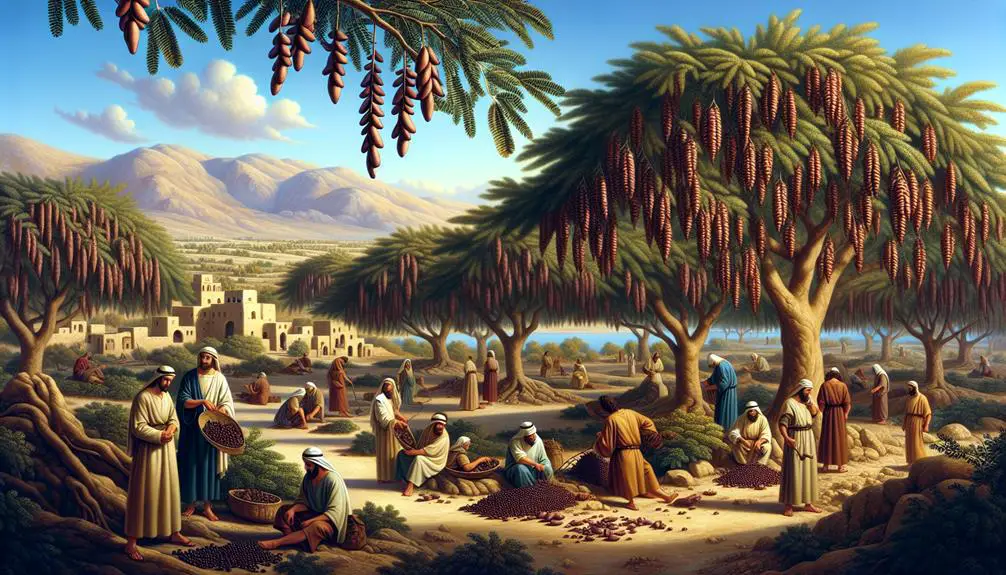
Amidst the tapestry of ancient dietary practices, carob stood out as a vital source of nutrition and sustenance for various civilizations. Its cultivation, deeply rooted in the fertile lands of the Mediterranean, not only facilitated its integration into local cuisines but also underscored its significance across different cultures. As you delve deeper into the historical context, you'll find that carob's resilience and versatility made it an indispensable component of ancient diets.
Carob cultivation thrived in arid conditions where other crops might falter, making it a reliable staple during periods of drought or crop failure. Its pods, rich in sugar and nutrients, offered a natural sweetness and energy source that was highly prized. This characteristic allowed ancient peoples to use carob in a variety of culinary applications, from fresh consumption to ground flour for baking, showcasing its flexibility in Mediterranean cuisine.
Moreover, carob's nutritional profile — high in fiber, calcium, and antioxidants — complemented the predominantly plant-based diets of the time. Its ability to provide essential nutrients in a single, easily accessible form was invaluable, particularly in regions where food scarcity was a common challenge.
Analyzing carob's role in ancient diets reveals its integral place not only in daily sustenance but also in the broader fabric of Mediterranean culture. Its cultivation and consumption are testament to human ingenuity in harnessing nature's bounty, demonstrating how ancient civilizations optimized their resources to nourish their communities. In this context, carob wasn't merely a food item; it was a symbol of resilience and sustenance, woven into the very heart of ancient dietary practices.
Modern Spiritual Lessons

Reflecting on carob's historical significance, we can extract meaningful spiritual lessons that resonate with contemporary life. The journey of understanding these lessons begins with an examination of carob cultivation and its symbolic ties to resilience and growth, fostering a deeper connection to spiritual practices that are essential in today's fast-paced world.
- Sustainability and Stewardship: Carob cultivation teaches us the importance of sustainability and environmental stewardship. Unlike other crops that may demand extensive resources, carob thrives in arid conditions, symbolizing the virtue of making the most out of scarce resources. This lesson encourages you to adopt sustainable practices in your own life, recognizing the impact of your actions on the planet and fostering a harmonious relationship with nature.
- Patience and Perseverance: The growth cycle of the carob tree, from seedling to fruit-bearing, is a test of patience and perseverance. It serves as a metaphor for spiritual growth, emphasizing that meaningful development takes time and consistent effort. This lesson inspires you to embrace patience in your spiritual practices, understanding that enlightenment and understanding unfold gradually.
- Nourishment and Simplicity: Carob pods, once a staple in ancient diets, remind us of the value of simplicity and the nourishment that comes from mindful consumption. In a world cluttered with excess, carob's simplicity teaches you to find fulfillment in the basics, encouraging a spiritual practice that seeks depth and meaning over material abundance.
Frequently Asked Questions
How Can Carob Pods Be Incorporated Into Modern Culinary Practices for Those Inspired by Biblical Diets?
You can integrate carob pods into modern diets by embracing their versatility. Start by blending carob smoothies, a nutritious and chocolatey alternative for a healthy breakfast or snack.
Additionally, explore Mediterranean snacks by incorporating carob into recipes for bars, cookies, and bread. This approach not only adds a unique flavor but also taps into the nutritional benefits of carob, making your diet both innovative and inspired by ancient practices.
Are There Any Specific Rituals or Religious Ceremonies in Contemporary Times That Still Use Carob Pods as a Significant Element?
You're diving into a sea of tradition to uncover if carob pods still shine in modern rituals as they once did.
Carob symbolism, deeply rooted in history, whispers of sustenance and protection. Historically, these humble pods marked significant moments, bridging the mundane with the divine.
Today, their role is more nuanced, subtly woven into ceremonies that honor their past significance, yet they remain a symbolic nod to heritage and continuity in specific cultural practices.
How Has the Portrayal of Carob Pods in Media and Literature Evolved Since Ancient Times, and What Impact Does This Have on Public Perception Today?
You've noticed that carob pods have evolved in portrayal from simple, ancient symbols to complex cultural icons. This shift, deeply rooted in historical accuracy, impacts how you perceive them today.
The transformation in media and literature, infused with cultural symbolism, shapes your understanding. Analyzing this evolution offers insight into how ancient elements are reinterpreted, influencing modern views.
It's fascinating how historical narratives and cultural perspectives intertwine, affecting contemporary perceptions.
Can Carob Pods Be Used as an Effective Substitute in Recipes for People With Specific Food Allergies, Such as to Chocolate?
Yes, carob pods can indeed serve as a miraculous substitute for those with specific food allergies, especially to chocolate. With its chocolate alternative taste, carob offers a safe haven for your taste buds without the risk of allergic reactions.
Analyzing carob health benefits reveals its nutritional superiority, making it not just an allergy-friendly option but also a healthier choice. It's a win-win, blending both safety and indulgence seamlessly.
What Are the Environmental Impacts of Cultivating Carob Trees, and How Does It Compare to the Production of Other Crops Mentioned in the Bible?
When you delve into the environmental impacts of carob cultivation, it's clear it offers significant advantages. Carob trees are remarkably resilient, requiring less water than many crops, thus bolstering soil health and reducing erosion.
Compared to other ancient crops, carob's sustainability shines, making it an environmentally friendly choice. Its ability to thrive in arid conditions with minimal intervention positions carob as a superior option for sustainable agriculture.
Conclusion
In analyzing carob's presence in biblical narratives, you uncover a rich tapestry of spiritual and physical sustenance. Juxtaposed against manna, carob symbolizes humility and resilience, a contrast to divine providence.
Its mention in the Parable of the Prodigal Son underlines themes of repentance and sustenance in adversity. Modern reflections on carob's role in ancient diets reveal a complex interplay between necessity and faith, urging a reevaluation of what sustains us spiritually and physically in contemporary contexts.


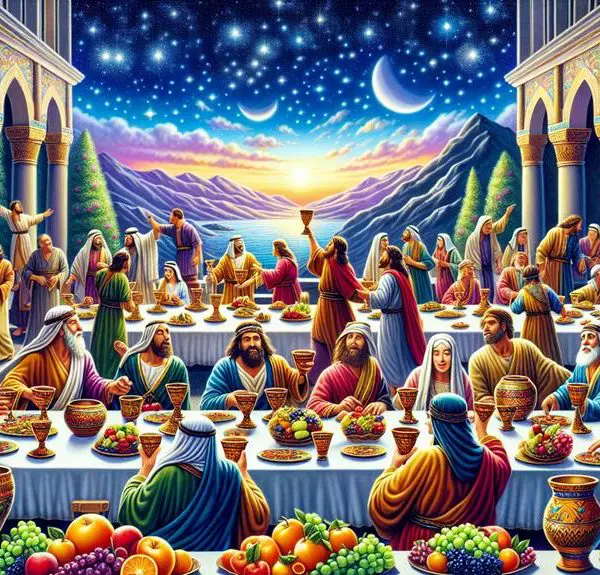
Sign up